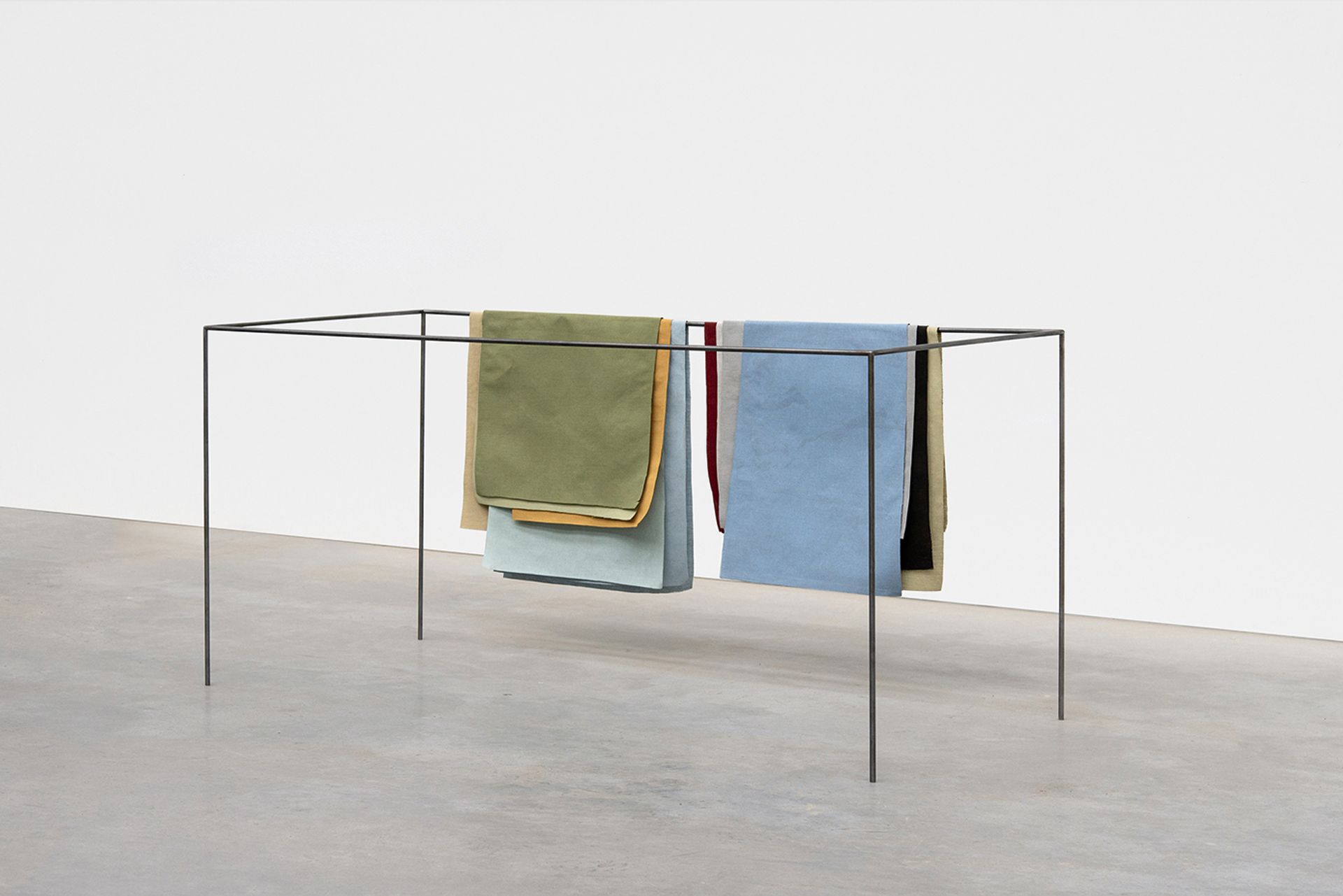The Dutch artist Mark Manders points to the almost imperceptible spaces between the tiny printed words on a vase-like sculpture in his studio. He considers these spaces decorative, referring to them as “ornaments”.
“I think about ornaments, of using them, but I’ve never been allowed before,” he tells The Art Newspaper, referring to one of his many self-imposed rules. “Everything must be as pure as possible. I have to find a reason to be able to use it.”
Manders also speaks of a time when he was “not allowed” to indulge his desire to use pedestals to display sculptures—and of another, when he struggled against the urge to introduce newspapers into his work as a material. Colour must abide by rules, too. Because a bathroom is typically white, he says, “there’s no freedom” in it. But since towels do not necessarily have that same colour default, he felt he could experiment with them; bronze casts of towels painted different hues thus became key elements in his sparse sculptural installation Isolated Bathroom (Composition with 4 colors) (2010-19), which he has described as a “three-dimensional painting”, and Table with Towels (1999-2023).

Table with Towels (1999-2023) Photo: Studio Mark Manders; courtesy the artist and Xavier Hufkens, Brussels
Manders’s artistic journey has been shaped by such unwritten rules, which are now foundational to his practice. His creative self-discipline will take centre stage at three major European venues this autumn: Art Basel Paris (16-20 October), where his work will feature on the stands of both Xavier Hufkens gallery and Tanya Bonakdar Gallery; his debut one-person exhibition at Hufkens’s space in Brussels (24 October-21 December); and Silent Studio (31 October-March 2025), a solo show at the Fondazione Sandretto Re Rebaudengo in Turin, Italy.
Quick thinking, slow process
Together, this series of events will finally give Manders, aged 56, the opportunity to realise ideas that often come to him in “seconds” but which can languish in discussion for years. Architecture, for example, will be key to the exhibitions at Xavier Hufkens and the Fondazione Sandretto Re Rebaudengo.
“The show at the foundation will be like a living studio, whilst the show at Hufkens will span the entirety of its 9,000-square-foot space, directly responding to the Robbrecht and Daem-designed building,” the artist says.
Over the past 30 years, Manders has built an international profile in the art world. He was the subject of solo shows at the Museum of Contemporary Art in Tokyo in 2021 and the Bonnefanten Museum in Maastricht in 2020. Critical acclaim also followed his solo presentation for the national pavilion of the Netherlands during the 2013 Venice Biennale.
Paradoxically, Manders establishes and abides by his many rules in order to explore more freely. “I’ve created a place I can think in and really take my time to develop ideas,” he says. It is a place not of suspended time but rather of no time at all. Manders, who makes all his own work himself, learned many of his skills from his father, who was a carpenter. His handcrafted furniture looks like it could have been made in the 1920s or 30s, while many of his sculptures—such as the painted bronze bust, titled Monument (2024), that will be on offer by Xavier Hufkens at Art Basel Paris—could be mistaken for antiquities.
Learning to let go
Walking around the artist’s four-building studio complex in the Belgian city of Ronse, where he also lives, one sees workspaces methodically organised by material. There are also sections with metal flooring to demarcate “display” areas from the rest of the studio’s spaces.
Given his extreme self-restraint and laser-focused attention to his surroundings, it may come as a surprise that Manders is relatively unconcerned about the lack of control he will have over where Tanya Bonakdar and Xavier Hufkens place his pieces in their respective stands at Art Basel Paris. “When you make a work that should survive everywhere, you to have to let it loose,” he says.
Manders’s tendency toward working at monumental scale could pose logistical and financial challenges for many collectors. But he has also often made smaller, more domestically friendly pieces, whose prices often settle around between $50,000 to $150,000.
The market’s response to his practice, however, is not a driving force in the artist’s mind. “I create for myself,” he says, before immediately complicating the entire concept of what he means by the self: “It’s a fictional person, I’m just the one who made it. The person who makes my work is neurotic, and I’m not.”
“If you get the system right, it generates ideas—reveals ways we think and the ways we live,” Manders adds. “I really enjoy my life, and I want to freeze something and share that.”


